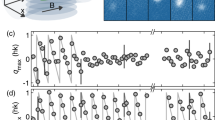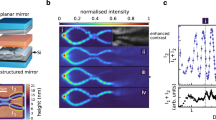Abstract
Pattern formation is ubiquitous in nature at all scales, from morphogenesis and cloud formation to galaxy filamentation. How patterns emerge in a homogeneous system is a fundamental question across interdisciplinary research including hydrodynamics1, condensed matter physics2, nonlinear optics3, cosmology4 and bio-chemistry5,6. Paradigmatic examples, such as Rayleigh–Bénard convection rolls and Faraday waves7,8, have been studied extensively and found numerous applications9,10,11. How such knowledge applies to quantum systems and whether the patterns in a quantum system can be controlled remain intriguing questions. Here we show that the density patterns with two- (D2), four- (D4) and six-fold (D6) symmetries can emerge in Bose–Einstein condensates on demand when the atomic interactions are modulated at multiple frequencies. The D6 pattern, in particular, arises from a resonant wave-mixing process that establishes phase coherence of the excitations that respect the symmetry. Our experiments explore a novel class of non-equilibrium phenomena in quantum gases, as well as a new route to prepare quantum states with desired correlations.
This is a preview of subscription content, access via your institution
Access options
Access Nature and 54 other Nature Portfolio journals
Get Nature+, our best-value online-access subscription
$29.99 / 30 days
cancel any time
Subscribe to this journal
Receive 12 print issues and online access
$209.00 per year
only $17.42 per issue
Buy this article
- Purchase on Springer Link
- Instant access to full article PDF
Prices may be subject to local taxes which are calculated during checkout




Similar content being viewed by others
References
Cross, M. C. & Hohenberg, P. C. Pattern formation outside of equilibrium. Rev. Mod. Phys. 65, 851–1112 (1993).
Mouritsen, O. G. Pattern formation in condensed matter. Int. J. Modern Phys. B 04, 1925–1954 (1990).
Arecchi, F., Boccaletti, S. & Ramazza, P. Pattern formation and competition in nonlinear optics. Phys. Rep. 318, 1–83 (1999).
Liddle, A. R. & Lyth, D. H. Cosmological Inflation and Large-Scale Structure (Cambridge Univ. Press, 2000).
Turing, A. M. The chemical basis of morphogenesis. Phil. Trans. R. Soc. Lond. B Biol. Sci. 237, 37–72 (1952).
Maini, P. K., Painter, K. J. & Chau, H. N. P. Spatial pattern formation in chemical and biological systems. J. Chem. Soc. Faraday Trans. 93, 3601–3610 (1997).
Bodenschatz, E., Pesch, W. & Ahlers, G. Recent developments in Rayleigh–Bénard convection. Annu. Rev. Fluid Mech. 32, 709–778 (2000).
Miles, J. On Faraday waves. J. Fluid Mech. 248, 671–683 (1993).
Edwards, W. S. & Fauve, S. Patterns and quasi-patterns in the Faraday experiment. J. Fluid Mech. 278, 123–148 (1994).
Lifshitz, R. & Petrich, D. M. Theoretical model for Faraday waves with multiple-frequency forcing. Phys. Rev. Lett. 79, 1261–1264 (1997).
Arbell, H. & Fineberg, J. Pattern formation in two-frequency forced parametric waves. Phys. Rev. E 65, 036224 (2002).
Swift, J. & Hohenberg, P. C. Hydrodynamic fluctuations at the convective instability. Phys. Rev. A 15, 319–328 (1977).
Pomeau, Y. & Manneville, P. Intermittent transition to turbulence in dissipative dynamical systems. Commun. Math. Phys. 74, 189–197 (1980).
Sakaguchi, H. & Brand, H. R. Localized patterns for the quintic complex Swift–Hohenberg equation. Physica D 117, 95–105 (1998).
Hoyle, R. Pattern Formation: An Introduction to Methods (Cambridge Univ. Press, 2006).
Landau, L. D. & Lifshitz, E. M. Fluid Mechanics Vol. 6 (Course of Theoretical Physics, Pergamon Press, 1959).
Temam, R. & Chorin, A. Navier Stokes Equations: Theory and Numerical Analysis (AMS Chelsea Publishing, 1978).
Ardizzone, V. et al. Formation and control of Turing patterns in a coherent quantum fluid. Sci. Rep. 3, 3016 (2013).
Engels, P., Atherton, C. & Hoefer, M. A. Observation of Faraday waves in a Bose–Einstein condensate. Phys. Rev. Lett. 98, 095301 (2007).
Groot, A. Excitations in Hydrodynamic Ultra-Cold Bose Gases. PhD thesis, Utrecht Univ. (2015).
Nguyen, J. H. V. et al. Parametric excitation of a Bose–Einstein condensate: from Faraday waves to granulation. Phys. Rev. X 9, 011052 (2019).
Pollack, S. E. et al. Collective excitation of a Bose–Einstein condensate by modulation of the atomic scattering length. Phys. Rev. A 81, 053627 (2010).
Kronjäger, J., Becker, C., Soltan-Panahi, P., Bongs, K. & Sengstock, K. Spontaneous pattern formation in an antiferromagnetic quantum gas. Phys. Rev. Lett. 105, 090402 (2010).
Hung, C.-L., Gurarie, V. & Chin, C. From cosmology to cold atoms: observation of Sakharov oscillations in a quenched atomic superfluid. Science 341, 1213–1215 (2013).
Kadau, H. et al. Observing the Rosensweig instability of a quantum ferrofluid. Nature 530, 194–197 (2016).
Li, J.-R. et al. A stripe phase with supersolid properties in spin–orbit-coupled Bose–Einstein condensates. Nature 543, 91–94 (2017).
Böttcher, F. et al. Transient supersolid properties in an array of dipolar quantum droplets. Phys. Rev. X 9, 011051 (2019).
Tanzi, L. et al. Observation of a dipolar quantum gas with metastable supersolid properties. Phys. Rev. Lett. 122, 130405 (2019).
Chomaz, L. et al. Long-lived and transient supersolid behaviors in dipolar quantum gases. Phys. Rev. X 9, 021012 (2019).
Clark, L. W., Gaj, A., Feng, L. & Chin, C. Collective emission of matter-wave jets from driven Bose–Einstein condensates. Nature 551, 356–359 (2017).
Fu, H. et al. Density waves and jet emission asymmetry in Bose fireworks. Phys. Rev. Lett. 121, 243001 (2018).
Chin, C., Grimm, R., Julienne, P. & Tiesinga, E. Feshbach resonances in ultracold gases. Rev. Mod. Phys. 82, 1225–1286 (2010).
Feng, L., Hu, J., Clark, L. W. & Chin, C. Correlations in high-harmonic generation of matter-wave jets revealed by pattern recognition. Science 363, 521–524 (2019).
Abe, H. et al. Faraday instability of superfluid surface. Phys. Rev. E 76, 046305 (2007).
Hung, C.-L. et al. Extracting density–density correlations from in situ images of atomic quantum gases. New J. Phys. 13, 075019 (2011).
Hu, J., Feng, L., Zhang, Z. & Chin, C. Quantum simulation of Unruh radiation. Nat. Phys. 15, 785–789 (2019).
Petrov, D. S., Holzmann, M. & Shlyapnikov, G. V. Bose–Einstein condensation in quasi-2D trapped gases. Phys. Rev. Lett. 84, 2551–2555 (2000).
Acknowledgements
We thank K. Patel for careful reading of the manuscript. This work is supported by National Science Foundation (NSF) grant no. PHY-1511696, the Army Research Office Multidisciplinary Research Initiative under grant no. W911NF-14-1-0003 and the University of Chicago Materials Research Science and Engineering Center, which is funded by the NSF under grant no. DMR-1420709. J.H. acknowledges financial support from the National Natural Science Foundation of China under grant no. 11974202.
Author information
Authors and Affiliations
Contributions
Z.Z. and K.-X.Y. performed the experiments, built the theoretical model and analysed the data. L.F. contributed to development of the modulation hardware and pattern recognition scheme. J.H. contributed to the discussion of the results. C.C. supervised the work. All authors contributed to writing the manuscript.
Corresponding author
Ethics declarations
Competing interests
The authors declare no competing interests.
Additional information
Peer review information Nature Physics thanks Simon Cornish and other, anonymous, reviewer(s) for their contribution to the peer review of this work.
Publisher’s note Springer Nature remains neutral with regard to jurisdictional claims in published maps and institutional affiliations.
Supplementary information
Supplementary Information
Supplementary Information.
Source data
Source Data Fig. 2
Correlation of D6 pattern formation.
Source Data Fig. 3
Spatial correlation for different schemes.
Source Data Fig. 4
Angular correlation and phase histogram.
Rights and permissions
About this article
Cite this article
Zhang, Z., Yao, KX., Feng, L. et al. Pattern formation in a driven Bose–Einstein condensate. Nat. Phys. 16, 652–656 (2020). https://doi.org/10.1038/s41567-020-0839-3
Received:
Accepted:
Published:
Issue Date:
DOI: https://doi.org/10.1038/s41567-020-0839-3
This article is cited by
-
Polygonal patterns of Faraday water waves analogous to collective excitations in Bose–Einstein condensates
Nature Physics (2024)
-
Turing instability in quantum activator–inhibitor systems
Scientific Reports (2022)
-
Crystallization of bosonic quantum Hall states in a rotating quantum gas
Nature (2022)
-
Quantum gases in optical boxes
Nature Physics (2021)
-
Tailoring quantum gases by Floquet engineering
Nature Physics (2021)



